What is Being John Malkovich about?
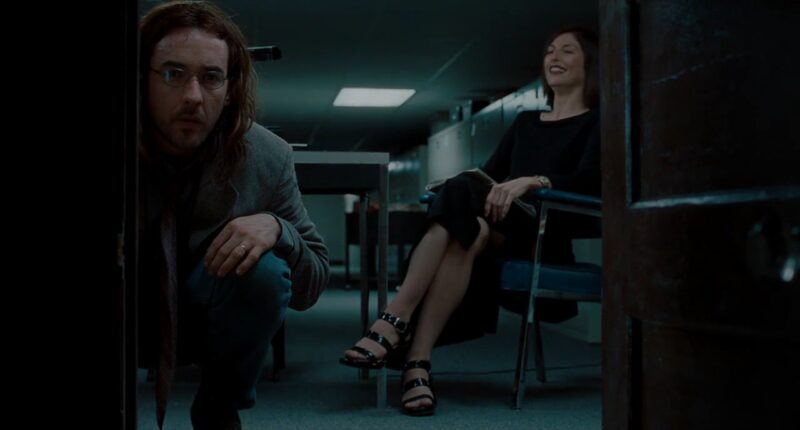
Being John Malkovich is all about, ironically enough, being yourself. When Craig enters the mind of John Malkovich, he believes he is seeing the world through a new set of eyes—but really, it’s just him. He might be in a different body, but it’s still his same mind. And, thus, his same fears, his same anxieties.
Craig is at a crossroads in life, desperate for a change that will bring him fulfillment. But instead of working on himself, Craig sees John Malkovich as a shortcut. From here, Being John Malkovich becomes a satiric, Kafkaesque exploration of self-actualization. When people look at you, what do they see? When you look into the mirror, who do you see? Over the course of time, who have you become? The vessel you inhabit is irrelevant. It’s all about how you live your life. And shortcuts will only limit your potential.
That is the promise that Lotte and Maxine represent, that Dr. Lester and his crew represent. Through John Malkovich, Lotte and Maxine are able to see each other for who they truly are. And because of it, they’re able to envision and actualize the kind of life they can build together. And Dr. Lester and his team don’t want to just inhabit John Malkovich and milk his fame. They wish to live forever, to grow and evolve as they pass from vessel to vessel. There’s something poetic about their plight that makes Craig’s seem trivial and cynical.
Movie Guide table of contents
Cast
- John Cusack – Craig Schwartz
- Cameron Diaz – Lotte Schwartz
- Catherine Keener – Maxine Lund
- John Malkovich – John Horatio Malkovich
- Orson Bean – Dr. Lester
- Mary Kay Place – Floris
- Charlie Sheen – himself
- W. Earl Brown – First J.M. Inc. Customer
- Carlos Jacott – Larry the Agent
- Byrne Piven – Captain James Mertin
- Octavia L. Spencer – Woman in Elevator
- Charlie Kaufman – Writer
- Spike Jonze – Director
The ending of Being John Malkovich explained
When you read the plot summary for Being John Malkovich—a movie where people go through a portal to be inside John Malkovich’s head—a number of existential and philosophical questions arise. What does it mean to see the world through somebody else’s eyes? To think and move and feel differently? By escaping your own body, do you escape your problems? What is the nature of self? Does a soul exist? Are you living your life on your own terms? Or are you subscribing to a learned model?
Basically, to boil everything down to one central query: are you truly, you know…you?
And this is all before you even watch the movie. Oof.
Then you actually watch the film and all other kinds of questions about love and art and perspective and sexuality and legacy abound. Naturally, you’re curious about the themes of Being John Malkovich and the core message of the movie. So you go on an internet search to find what the now-famous screenwriter Charlie Kaufman has to say about his breakout film. And you find…
Nothing.
Seriously. I looked. There are a few interviews available with Kaufman—like this one and that one and oh yeah don’t forget about this one over here—and in none of them does he offer anything resembling a concrete answer. I mean, jeez, the guy even wrote an article for The Guardian called “Why I Wrote Being John Malkovich”, during which he never tells you why he wrote Being John Malkovich. Sure, Kaufman tells you that he decided to write the screenplay while waiting for “sitcom hiring season”—but he doesn’t tell you why he wrote the movie, or what compelled him to spew dozens of philosophical questions onto a page via a strange plot about climbing into an Oscar-nominated actor’s mind palace.
The closest answer we get? In the interview with Filmmaker magazine, Kaufman tells us what the movie isn’t about. At one point during the discussion, the interviewer, Scott Macaulay, says that “The Hollywood version of this movie would end with the characters realizing that they have to be themselves.”
“Well, God forbid!” Kaufman responds. “I don’t want to subscribe to that, and I certainly don’t want to tell anybody what they have to be. I guess it is possible that people will think that’s what the movie’s about.”
I know that’s not much to go on. But, as it turns out, this lone bit of reflection is the crucial bit of insight we need to unlock what exactly Being John Malkovich is about.
I guess what Kaufman’s response really makes me think of is those final moments of the movie, where Craig’s wife Lotte and Maxine, he woman Craig is lusting after at work, are holding each other while their daughter is looking at them. And we hear Craig trapped the little girl’s head, asking her to “look away” over and over.
While Kaufman is right that the movie isn’t really about “being yourself,” that theory does set us in the right direction. There’s something much deeper happening with identity and realizing one’s place in this world. It’s not necessarily about “being yourself,” but instead “finding your actualized self.”
In fact, there’s a quote from Lotte in the movie that supports this. After going into John Malkovich’s mind, Lotte discovers that she wants to be a man. And when Craig tells her she’s being crazy, she screams, “Don’t stand in the way of my actualization as a man!”
At Film Colossus, we look for “in-roads” that help us analyze what a movie is about—and to me, this was a giant clue. Because this immediately recalls a psychological theory called “self-actualization” put forth by Abraham Maslow in the 20th century.
So this quote made me think: are each of these characters on a search for self-actualization?
A self-actualized person (I’ll provide more details on what that exactly means in the next section) is somebody who is completely in tune with themself—something Craig seriously struggles with. Craig is on a psychological journey called “self-actualization” in which he tries to realize his full potential as a man and as an artist. But Craig’s problem is that he chases self-actualization without understanding the virtue of becoming your whole self. He is only interested in what benefits his selfish goals—which is in opposition to the other characters of the film, who all find fulfillment by helping and connecting with other people.
In this article, we will review Craig’s story and show how the film explores this philosophical journey (and how Craig tries to cheat his way to the top (and fails)). But first, let’s get a grasp on what exactly “self-actualization” means.
The Mas-lowdown on self-actualization
Abraham Maslow was this guy who lived from 1908-1970. He was a celebrated American psychologist who put forth lots and lots of new ideas. He pushed the boundaries of psychology with his theories about humanistic psychology and peak experiences and transpersonal psychology. Dude was prolific as hell.

But his biggest and most controversial contribution to the psychology world was self-actualization (more on why it was controversial later). In his book, A Theory of Human Motivation, he defines self-actualization as “self-fulfillment, namely the tendency for him [the individual] to become actualized in what he is potentially. This tendency might be phrased as the desire to become more and more what one is, to become everything that one is capable of becoming.”
Basically, Maslow believes that if you’re able to purely concentrate on your growth as opposed to your deficiencies, then you can propel yourself towards reaching your full potential. From the time you wake up to the moment when you go to bed—while eating and exercising and conversing with your friends and family—your focus should be on your personal growth. When you live like that? Then you can become who you were always meant to be and maximize your worth and contributions to the world.
Here’s the thing, though: you can’t just suddenly start living your self-actualized life. Maslow believes there is a “hierarchy of needs” that lead to true fulfillment. The process is represented here in this pyramid:
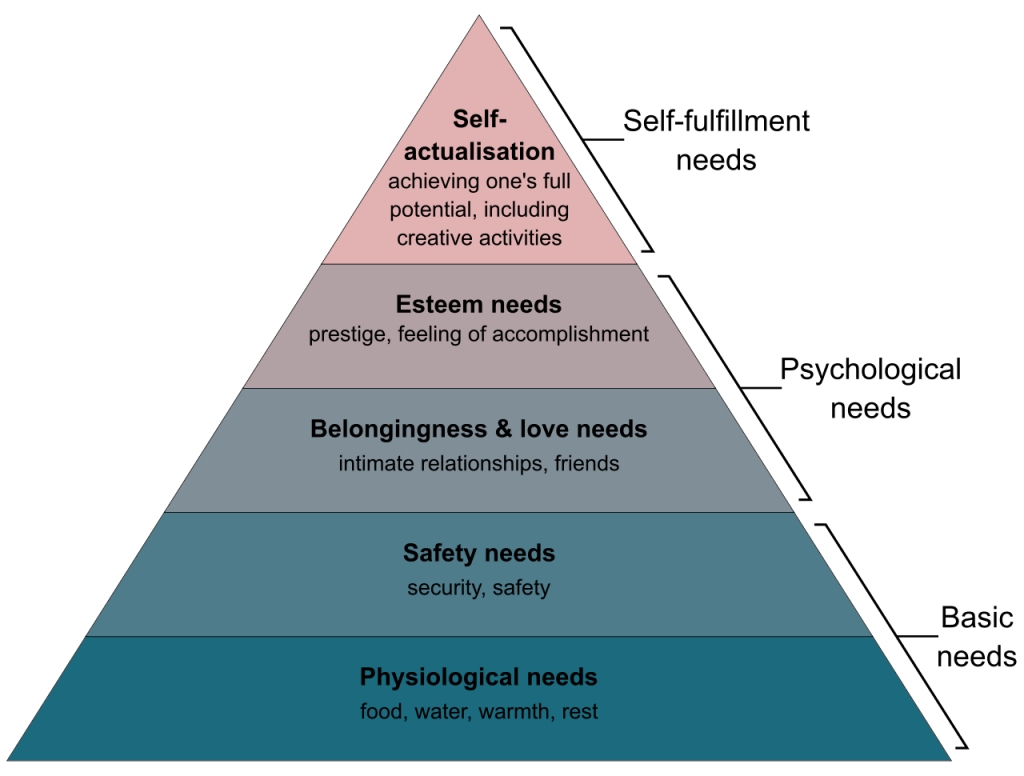
Just in case you can’t see that image, the order goes:
- Psychological needs (such as food and water)
- Safety needs (employment and health)
- Love and belonging needs (friendship and family)
- Esteem needs (respect and self-esteem)
- Self-actualization needs (your full potential)
Basically, there is a process that leads to self-actualization. Going through those first four steps—in which you take care of your body, surround yourself with loving people, and attend to yourself mentally—lays the foundation for fulfillment and allows you to grow and mature so that you are emotionally ready to take on this life-defining task.
And therein lies the flaw in self-actualization: some people don’t want to put in the work required in those first four steps. Your ego could lead you to believe you are living a self-actualized life. But unless you cover the basic necessities you need as an emotionally stable and thoughtful person, you won’t realize your unique abilities and assets as a human being. If you just choose to bypass those first four steps…well, that’s trouble. Changed “intelligent” to “thoughtful” as I think people associate intelligence with something you’re born with while being thoughtful is more something within your control. Pedantic Chris signing off (for now).
The German psychiatrist Fritz Perls put it best. He thought that Maslow’s theory carried the risk of confusing “self-actualizing and self-image actualizing.” By conflating “the virtue of self-actualization and the reality of self-actualization,” Perls said in his book Gestalt Therapy Verbatim, people might consume themselves with the chase and ideal of self-actualization, as opposed to the gratification, the elation, the psychological pleasure that comes with actualizing your full potential.
An example of a good self-actualized person would be Johnny Utah (played by Keanu Reeves) in Point Break. Throughout the film, he’s torn between the good guys (the cops) and the bad guys (the surfers) on his search for self-actualization. Johnny believes in the rigidity of law and order, but he also feels free and in tune with his spirit while surfing. By the end of the movie, he learns that he must strike a balance between the two.
An example of a not-so-good actualized person? The first guy that comes to mind is Daniel Plainview from There Will Be Blood. Throughout the film, his one and only pursuit seems to be money, power, greed. And along the way, he burns every bridge imaginable to attain that wealth. His self-actualization has nothing to do with bettering the world or becoming part of the world. In fact, in the end, he makes it clear that he only attained his power so that he could remove himself from society completely. That’s why the final shot is of Daniel sitting alone in his giant mansion.
Weirdly enough, that closing shot of Daniel Plainview reminds me quite a bit of Craig in Being John Malkovich…
It’s a short climb for Craig…
A quick overview of Craig. The guy is a puppeteer—an unsuccessful puppeteer. And he believes the only reason he is unsuccessful at puppeteering is that the world does not understand his work. He desperately wants to convey the pains and emotions he feels as a human being, but has never been able to do that successfully through his art.
Here we find Craig’s end goal: to become a successful puppeteer.
And, maybe more than that: to become a successful artist. To reach people with his art. To change the world with his art. (To be honest, it’s pretty similar to Michael Keaton’s journey in Birdman.)
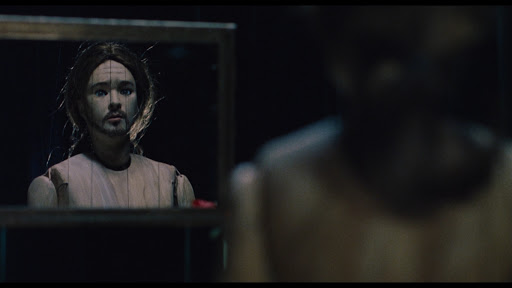
Those are all goals we can root for, right? Inherently, great art can create great change. A well-told story, a beautiful painting, a soaring melody can move us and teach us things about ourselves and about us collectively as a society.
But…is any of that part of Craig’s mission? It doesn’t seem so. We can tell that he is passionate about his art. But what are his intentions with his art? What does he truly aspire to achieve as a successful artist?
Here we can go back to Perls’s criticism of Maslow’s theory. People are often focused on the “reality” of self-actualization—which can be nothing more than a mirage, really. By becoming successful and renowned, you aren’t necessarily “self-actualized.” You must first understand the virtue of self-actualization—the inherent goodness and morality of becoming a fully realized individual. Then the task becomes fulfilling.
There are deeper questions you must first answer. What do you contribute to the world as a self-actualized person? What positive messages are you sending to people? What constructive change do you enact? How can people learn from your growth? When you have addressed those dilemmas, you can feel the contentment of being a self-actualized individual. You can feel as though your true self has a place in this wacky and wild world.
Like, say you’re a journalist. You started writing about news because you wanted to make an impact on the world—but, over time, you drift away from that goal. As you rise up the ranks at the newspaper, you write less and less and become more and more focused on advertising and profits.
Then one morning, you read an old story that you wrote—your first big story as a journalist that got you some recognition. This story really made a difference in your city because it forced local politicians to make some changes.
As you read this old story, you start to think about how much your career has changed. But more important than that: how much you have changed. And this forces you to wonder: am I making a difference in my current role a the newspaper? If not, does this mean I need to go back to writing? Or can I adjust my managing skills so that our newspaper can put out more articles like this?
Basically: you start to wonder about how your own fulfillment can positively impact the world. By changing your ways, you can create some good, honest change that improves society.
A more narcissistic person, however, is entirely consumed with the self and rising to the top of the pack. Someone like Craig doesn’t really have answers to any of those questions I listed a few paragraphs up. All he cares about is the acclaim he will receive as an artist, the self-pride he feels in making Maxine his wife, the satisfaction of mastering control of John Malkovich’s body.
Craig does not understand the virtue of self-actualization. He is not interested in climbing the ladder of Maslow’s hierarchy of needs. In fact, he just leaps past the first four steps in order to achieve that final “satisfaction” of self-actualization—which in his mind is becoming the famous actor John Malkovich.
But that shortcut comes at a cost, as we see in those final moments of the film.
…but a long fall
We can think of the portal to John Malkovich’s mind as a representation of sidestepping the emotionally satisfying journey of self-actualization. As we go through Maslow’s hierarchy of needs, we can see how Kaufman and the director Spike Jonze use motifs and other characters to artistically capture Craig’s fears as a growing human being and showcase the danger of cheating the pyramid.
1. Psychological needs
These are biological requirements for human survival, e.g. air, food, drink, shelter, clothing, warmth, sex, sleep.
This is more of a basic step in the hierarchy of needs. As long as you have a roof over your head, water to drink, and food to eat, then you’re good. Right?
Kaufman presents an interesting twist to this step, though. Dr. Lester is introduced as Craig’s eccentric boss in the Mertin-Flemmer building. But eventually it is revealed that Lester knows about the portal and has been using it for years to take over people’s bodies so that he can, effectively, live forever.
As we’ll see by the end of the movie, Lester leads a much more fulfilling, self-actualized life. He’s able to pass from vessel to vessel, living forever. But when he does so, he brings lots of people with him on the journey. His quest to live forever isn’t selfless—it’s communal. Because Lester respects his vessel and the people he affects, he recognizes the need to take care of it by providing proper food and shelter. There is positive emotion behind the first level of the hierarchy.
Lester is often the source of comedic relief. But when we think about that base level of the hierarchy, a lot of his quirks and tendencies come to contrast the way Craig lives his life. Lester, who has lived for 105 years, drinks carrot juice—and “lots of it,” he says. “I swear, sometimes it’s not worth it. I piss orange. And I have to piss sitting down like a goddamn girlie-girl every fifteen minutes. But, nobody wants to die!” Craig, on the other hand, lives in squalor. His apartment is dirty (and filled with animals), his hygiene is unacceptable (that long, dirty hair, ugh…), and his diet is poor (he drinks lots and lots of light beer (and weirdly seems proud of it?)).
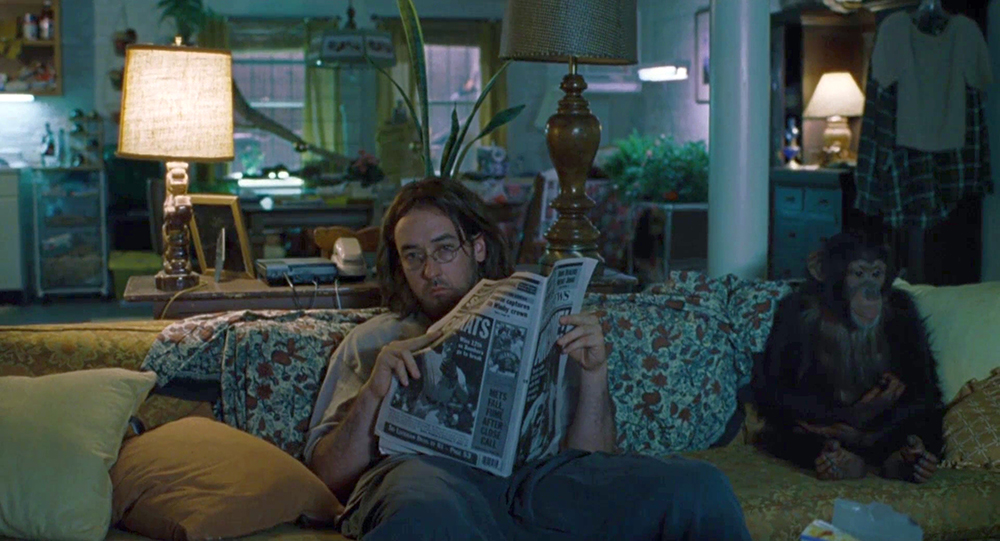
2. Safety needs
Once an individual’s physiological needs are satisfied, the needs for security and safety become salient. People want to experience order, predictability and control in their lives. These needs can be fulfilled by the family and society (e.g. police, schools, business and medical care).
Here we can bring Craig’s wife, Lotte, into the equation. Lotte quietly hints that she’d like to have a baby with Craig, to start a family, to create a more loving, cooperative environment.
This speaks to Lotte’s real dilemma throughout the film: she doesn’t feel safe living the life she lives. She is an affectionate, benevolent person who cares for of dozens of animals. She even takes her pet chimpanzee, Elijah, to a shrink. Lotte recognizes the importance of building a healthy, safe environment so that she can bring new people into the world and contribute to society.
Craig is the opposite. When Lotte pokes him about starting a family, he shies away. When Lotte pushes him to go get a job, he sees it as a hindrance to his career as an artist, and not as a way to improve their living conditions and build a foundation to start a family. When he cares for Elijah, he doesn’t do it out of duty or selflessness—he does it because Lotte tells him to.
In fact, when Craig does care for Elijah, he just complains about how unfair everything is. “You don’t know how lucky you are being a monkey,” Craig says while sitting on the couch with Elijah. “Because consciousness is a terrible curse. I think. I feel. I suffer. And all I ask in return is the opportunity to do my work.”
As we’ll learn later, Elijah has deep-set psychological issues because he was separated from his parents years ago. Lotte recognizes that there are mental issues with Elijah and takes him to the shrink—she creates a safety net. But Craig is entirely self-consumed, unaware of these issues, and instead complains about…existing. He is unable to find peace in his own body.
We can see how this leads to differences between Craig and Lotte’s respective experiences in the portal. When Craig inhabits John Malkovich, he feels safe because it’s an escape from his own life. But Lotte feels as though she’s discovering her true self. Or, as how Lotte herself puts it, her “actualization as a man.”

For Lotte, the experience of becoming John Malkovich is part of her self-actualization, her journey towards the end of the movie when she will become the father to Maxine’s child.
And that’s the beauty of Lotte’s journey. From the very beginning, she strived to complete the second step of the hierarchy of needs. And by the end, we see her living a happy, fulfilling life with a child of her own because she took the time to realize that need.
Craig, on the other hand…well, we’ll get to that once we reach the fifth stage.
3. Love needs
After physiological and safety needs have been fulfilled, the third level of human needs is social and involves feelings of belongingness. The need for interpersonal relationships motivates behavior.
When Craig sees Maxine for the first time, he is smitten. He stares at her from afar lustfully, and is drawn to the way she carries herself.
Is it because she’s attractive? Of course. But there’s a deeper layer to it: she is the opposite of Lotte.
Maxine exhibits femme fatale energy. She’s smart, cunning, and devilish, while Lotte is quiet, humble, and caring. Maxine wears red lipstick and talks about her breasts, while Lotte has wild unkempt hair and dons baggy clothing. For Craig, Maxine represents yet another way to escape his unfulfilling life. Whereas Lotte illustrates his imprisonment.
On the surface, Maxine isn’t the kind of character we’d root for. She exhibits an energy that Craig—who is a selfish person that doesn’t aim to live virtuously—would like to be part of his life. She seemingly doesn’t care about the psychological stakes of crawling into John Malkovich’s brain, and instead would like to exploit it for cash by charging people $200 to go into the portal.
That is until she meets Lotte. Maxine can sense Lotte in Malkovich’s eyes when Maxine and Malkovich go on a date. “Behind the stubble and the too prominent brow and the male pattern baldness, I sensed your feminine longing,” Maxine tells Lotte. “And it just slew me.”
Here is where Maxine’s arc begins. Yes, she is already very much herself. But what she doesn’t have is a feeling of belongingness. She appears to live a very lonely life (she spends a lot of late nights at work) doesn’t have someone else to make her feel whole.
Then comes Lotte, who forces Maxine to start thinking about things other than money and power when it comes to the portal. At one point, Maxine gladly closes up shop early in order to meet up with Lotte while Lotte is in Malkovich’s body.
That’s the difference between Craig and Lotte when it comes to Maxine. Craig sees Maxine as an accessory to his new life, as a prize that he’s won. But Lotte loves Maxine for who she is. Lotte is someone who wishes to become a man and be a father, and she sees a future with Maxine that doesn’t involve power or dominance. So when the movie ends with Lotte and Maxine sitting with their daughter Emily, you can see the first three steps of the hierarchy neatly in place.
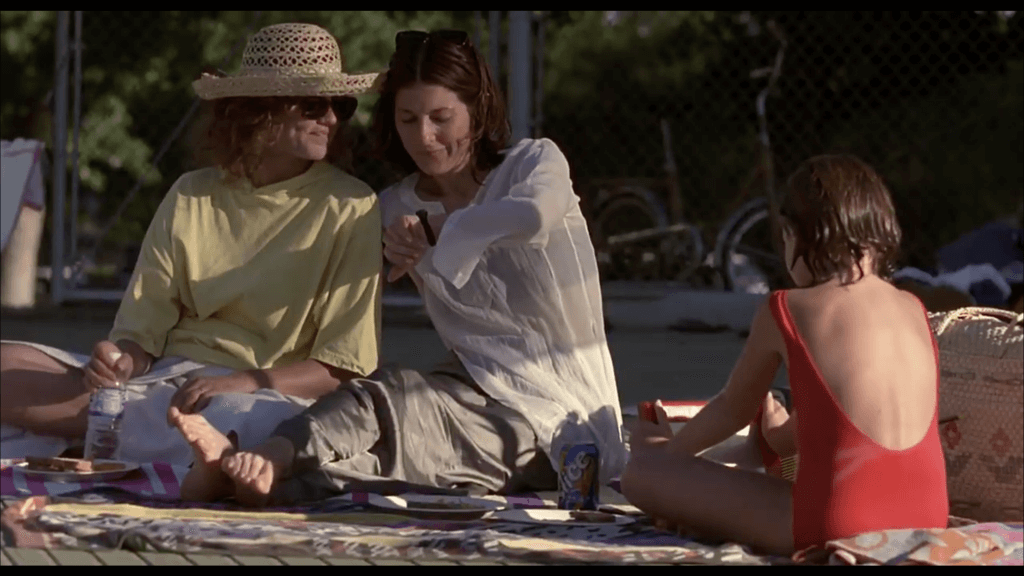
4. Esteem needs
This step comes in two categories: (i) esteem for oneself (dignity, achievement, mastery, independence) and (ii) the desire for reputation or respect from others (e.g., status, prestige).
You can see how Lester, Lotte, and Maxine have put in the work to set up this fourth step. While they each focus on themselves and their respective growths, they also each make sure that their self-actualization brings goodness into the world. They try to help others and provide fulfillment to others. Their actions are, largely, selfless.
That’s not the case with Craig. As we’ve seen, he has no respect for others. He uses John Malkovich to attain prowess, he locks Lotte in a cage to get what he wants, and he lusts after Maxine because he understands how she can help him capture more power. And because this is how he treats people, he doesn’t receive any respect in return.
Even worse is that he has no respect for himself. One of the most striking images of the movie is when Craig, as John Malkovich, controls a human-sized puppet of Craig’s former body at a musical. For Craig, this is the height of his artistic career. It is his chance to finally realize his ambitions as a puppeteer and captivate a wider audience.
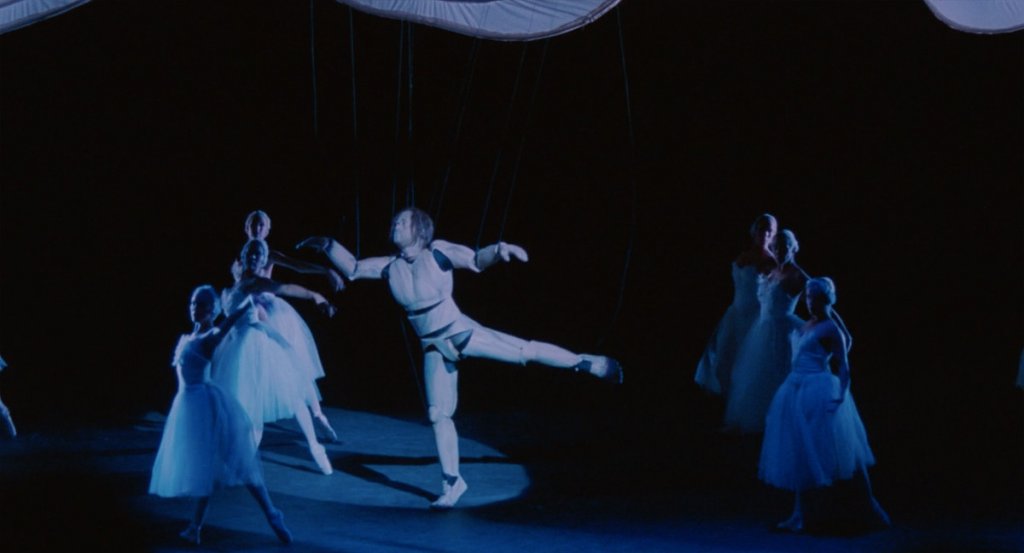
This is also a symbolic moment for Craig, as he believes this is a moment where he has mastered himself, where he has achieved independence. But he didn’t achieve this autonomy by attending to himself mentally and emotionally, but instead by escaping his vessel and then arrogantly maneuvering his older body with strings. For Craig, his grand show, his magnum opus, his defining piece of art isn’t the puppet show—it’s the ability to cheat life. To him, puppeteering never represented art or the good he could bring to the world, but instead a chance to control how the world saw him. Why put in the work to grow and better yourself if you can just make the world believe that you’re awesome and accomplished?
As you can see, the esteem for Craig—both internally and externally—is manufactured. He doesn’t respect himself or others. He’s only used people as pawns on a chessboard in order to fabricate a sense of esteem. But what did any of that lead to? What fulfillment does Craig feel after his actions caused everyone around him to run away? What true artistic achievement is there when you just cheat your way to the top?
5. Self-actualization needs
The realization of a person’s potential, self-fulfillment, seeking personal growth and peak experiences. Maslow describes this level as the desire to accomplish everything that one can, to become the most that one can be.
Because Craig had, for a majority of the film, gotten away with sidestepping the hierarchy of needs in his quest for self-actualization, he believes he can do it again at the end of the movie. After he is booted from Malkovich’s body and loses Maxine to Lotte, he screams, “Maxine! I’m going to go right back into Malkovich, kick Lester out, and then you’ll love me again!” It’s clear that Craig has not learned his lesson and plans to go right back to old behaviors.
There is a slight problem with that plan, however. As Lester explained earlier in the film, a host body becomes “ripe” after 44 years. That means that on John Malkovich’s 44th birthday, Lester and his friends will be able to take full control of Malkovich’s body and assume it until the next vessel is available.
There’s a catch, though. If you enter the portal after midnight of that 44th year, you will instead be forever trapped in the next newborn vessel, helplessly floating in that host’s subconsciousness.
Which is right where we find Craig at the end of the movie. “Maxine. Maxine. I love you, Maxine,” Craig whispers from inside the child’s mind. “Oh, look away. Look away. Look away. Look away. Look away. Look away. Look away. Look away.”
In those final moments, we hear Craig trying to puppet the child—and failing. He is imprisoned in the child’s mind, forever unable to control her the way he controlled Malkovich. And how fitting is it that the child belongs to Lotte and Maxine—two people who were able to actualize their selves, and will be able to teach their child to actualize her self.
This ending is Craig’s punishment for jumping past the first four steps of the hierarchy of needs. Because he failed to enrich his life with these other human necessities and instead chased fame, he could never truly experience the needs of self-actualization. He could never be fully realized. He could never reach his full potential. And for that, he will suffer.
I love how the ending of the movie juxtaposes the shot where Craig first looked into the portal. When he discovers the gateway, all he sees is a chance to escape. But in the end, that escape became his imprisonment.
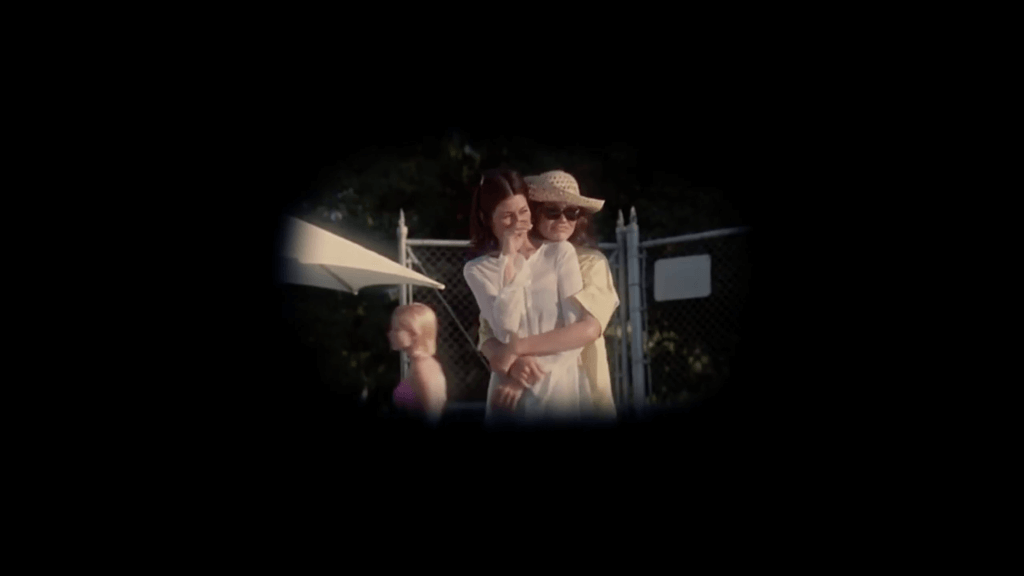
The themes and meaning of Being John Malkovich
1. Reaching your full potential
In the 20th century, renowned psychologist Abraham Maslow put forth an important (and controversial) theory called self-actualization. Basically, he created a pyramid called the “Hierarchy of Needs” that outlined how somebody can truly attain self-fulfillment. Those steps involve caring for yourself (health, food, shelter), becoming part of a group (family, friends), and tending to yourself mentally (respect, self-esteem).
In Being John Malkovich, you see each character working their way through the hierarchy. Being inside John Malkovich’s mind forces each character to change their perspective on the world and how they fit into it.
2. The meaning of art
While there are several character to follow in Being John Malkovich, Craig becomes the main character with the most screen time. Thus, much of the movie centers on Craig’s rise in the world as an artist. Which inherently begs the question: what does Craig’s art represent?
For years, Charlie Kaufman struggled to push his eccentric ideas and find his identity in Hollywood. So, in many ways, the film becomes a reflection of Kaufman’s struggles and his relationship with art. Your art means one thing to the public, but another thing to yourself. What is the difference? What drives you as an artist? What are you saying with your art? These are all questions at the heart of Craig’s journey.
Why is the movie called Being John Malkovich?
The title is both extremely obvious…and an existential headache that cannot be answered by our mere mortal brains with a cursory understanding of the extents of the universe and whatever spiritual realm lies outside of it. So, yeah.
Essentially: when Craig, or anyone else, is “being John Malkovich,” who are they really being? They’re in John Malkovich’s body, but they think and act like themselves. All that’s changed is the vessel and how people see that vessel. By “being John Malkovich,” Craig is ironically receiving an opportunity to realize his full potential.
However, as we discussed in the ending explanation, he fails to do so. He uses John Malkovich to sidestep his own personal growth, his self-actualization. He thinks he can “be” somebody else. But no matter what body he steps into…he’s always going to be Craig. To deny ourselves—or our selves—is to deny a fundamental component of living, of finding existential fulfillment.
In this way, the title is ironic. Yes, the movie is a fun sci-fi romp about entering the mind of actor John Malkovich. But this trip inside mind of John Malkovich forces us to evaluate ourselves and wonder what we’d do inside another vessel. You can’t stop being “you.” Being inside John Malkovich’s body doesn’t give you all his talent and intellect—that’s still on you. It’s on you to continue to develop and grow and foster meaningful relationships
Thus, Being John Malkovich becomes the ultimate defamiliarization: how do you find yourself…when it feels like you’ve lost yourself? When you look in the mirror and see somebody else? When it feels like nothing you do or say moves you forward? This perspective from another body forces you, more than any other moment in your life before it, to evaluate who you truly are.
Important motifs in Being John Malkovich
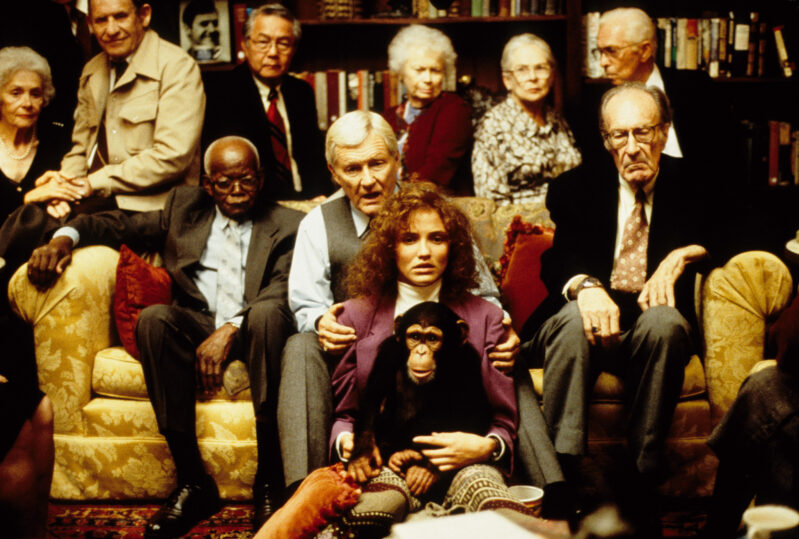
Perspective
Each of the characters in Being John Malkovich is on a search for self-actualization—which, according to Maslow, means reaching your full potential as a human being. In what ways does John Malkovich’s perspective force these characters to confront who they truly are?
Puppets
Craig—a struggling, unsuccessful puppeteer—believes that gaining control of John Malkovich will become his masterwork. What does that say about Craig’s relationship to his art? And how he views himself in his own art? What is the relationship between Craig and the puppet of himself?
Animals
There are several animals throughout the film, including a monkey named Elijah—who eventually becomes one of the more crucial characters of the film. Craig and Lotte’s pet chimpanzee comes to represent a primitive version of Craig. How does what we learn about Elijah contrast Craig and his struggles?
Aging
Throughout the movie, there are several comments about aging and what it means to live a long, healthy life—especially from Craig’s boss, Lester (who, as we find out, has lived a very, very long time). How do these comments and plot devices play into Craig’s existential crisis?
Love vs. Sex
Both Craig and Lotte become attracted to Maxine—for very different reasons. What is the meaning behind each of their infatuations? And how do those fascinations dictate the trajectories of their respective journeys? What does love provide for Lotte. And lust provide for Craig?
Questions & answers about Being John Malkovich

Is Being John Malkovich satire?
Yes! Satire uses absurdist humor, and Being John Malkovich is very much an absurd film, with little quirks like floor 7-and-a-half in the office building. That is confirmed by the textbook definition of satire: “the use of humor, irony, exaggeration, or ridicule to expose and criticize people’s stupidity or vices, particularly in the context of contemporary politics and other topical issues.” So…humor, irony, exaggeration, ridicule—yup, that all checks out.
In the case of Being John Malkovich, the absurdist tone is tackling the issue of self-actualization—the existential struggle to achieve fulfillment through our selves. Writer Charlie Kaufman uses Craig as his (no pun intended) puppet for this exploration. Specifically, Kaufman tackles the idea that celebrity and fame can bring fulfillment to your life. As we discussed in the ending explanation, Craig believes he can sidestep all the hard work and commitment it requires to actualize your true self by jumping into a celebrity’s body. But you can’t do that. As we discussed in the title section, you will always be yourself, and you’ll always need to work on yourself. You don’t become John Malkovich when you jump inside his body—you’re still you. And the fact that Craig doesn’t understand this is a reflection of his stupidity. Even in John Malkovich’s body, he’ll still be a miserable person.
Was Get Out inspired by Being John Malkovich?
If you’ve seen both Get Out and Being John Malkovich, then you might have had the same thought this Reddit user had: are these movies…connected? Do they exist in the same universe? Did Jordan Peele purposely nod to Charlie Kaufman’s Kafkaesque creation almost twenty years later?
Here’s u/postanalytical’s theory on Reddit:
BJM ends with what appears to be a happy ending for Maxine (Keener) and Lotte, who are raising a daughter (fathered by John Malkovich) together. Unbeknownst to them, Craig is trapped within the mind of their daughter, unable to control her like he could with her father. With Malkovich’s portal permanently closed, to Maxine it appears that the body-snatching technology has been lost. If she ever needed it again, she would have had to explore other avenues. She and Lotte may have sought out any remnants of the elder cabal that hadn’t entered Malkovich’s mind. Maxine may have seduced a neurosurgeon, like she did with Craig, to ensure his loyalty and utilize his skills. Lotte could have been one of the first attempts at the brain transplant; in Get Out it’s implied that the surgery is not always successful. To avoid suspicion Maxine, the elders, and the neurosurgeon would craft new identities as a liberal family living out in the woods. Maxine’s daughter, unknowingly carrying the malevolent spirit of the wretched Craig, would grow up to be a murderous sociopath incapable of love, who’s only goal in life would be to ensnare new victims.
Believe it or not, this theory gained such traction that Jordan Peele, director of Get Out, had to respond. In this video he recorded for Vanity Fair, he answers the question.
Here’s Peele’s exact quote regarding the theory:
I love this theory, I have heard this theory. It was definitely not lost on me that I was able to get Catherine Keener in her second like weird perspective, living in someone else’s brain movie. We joked about that and I’m a huge fan of the movie Being John Malkovich. I also sat down with [Being John Malkovich director] Spike Jonze a couple months ago, told him this theory myself and he chuckled. So as far as I’m concerned, it’s true.”
So there you have it. While it may not have been intentional, Peele is fully content with these movies existing in the same universe. Movie nerds, rejoice.
Why is Being John Malkovich about John Malkovich?
John Malkovich actually has the answer to this question. In an interview he did with The Independent, he discussed a conversation he had with Being John Malkovich writer Charlie Kaufman ahead of filming:
“Why not Being Tom Cruise I asked? Charlie told me quite clearly that he had no desire to change it and that [Spike Jonze] was going to direct, so I said OK. To be honest, I never actually thought that it would get made.”
As The Independent points out, “The movie indeed might never have been made had Kaufman not sent the screenplay to Francis Ford Coppola, who passed it on to Spike Jonze, who was married to his daughter Sofia at the time.”
Crazy stuff.
Did John Malkovich like Being John Malkovich?
He absolutely did. In an interview with Rolling Stone, Malkovich said:
I would say the film’s biggest legacy was that it was an introduction to the world of two extremely gifted filmmakers: Charlie Kaufman and Spike Jonze, whom I hold in great esteem. In my mind, they’re visionaries who have gone on to do some of the most excellent work in American movies for a long time. But [the legacy] for me, not so much. I mean, in modern culture… It’s kind of like if you get a blowjob from the wrong person, then your life becomes a blowjob. So Being John Malkovich always has to be referred to in some allegedly clever or ironic or snarky way.
Is Being John Malkovich Kafkaesque?
When something is referred to as “Kafkaesque,” it means the story—whether in the form of a book or a movie—draws from the works of the 20th-century Czech writer Franz Kafka. He is most well known for his novel “The Trial” and the short story “The Metamorphosis.” “Kafkaesque” is used to describe situations or narratives that are characterized by a nightmarish, surreal quality, senseless bureaucracy, overwhelming hopelessness, etc. All that fun stuff. In essence, Kafka depicted the individual’s struggle against an oppressive system.
Being John Malkovich is, on a base genre level, Kafkaesque as a surreal fantasy-comedy. But there are a number of other elements that bear resemblance to stories like “The Metamorphosis.” Here are some of the similarities between the movie and Kafka’s work:
- Surreal reality: The film presents a distorted reality that the protagonist must navigate.
- Loss of identity: Much like Gregor Samsa in “The Metamorphosis,” who wakes up as a giant insect, characters in Being John Malkovich lose their identity or have their identity usurped by others, leading to existential crises.
- Incomprehensible system: The bizarre, unexplained existence of the portal into Malkovich’s mind, and the rules governing its use, can be seen as a representation of an unfathomable system that characters must contend with.
- Struggle for control: Characters in the film, especially Craig, struggle to control and understand the strange circumstances they find themselves in, much like Kafka’s characters.
- Absurdity: Kafka’s works often center on the absurdity of life and the human condition. Being John Malkovich also embraces the absurd in its plot and characters.
Now it’s your turn
Have more unanswered questions about Being John Malkovich? Are there themes or motifs we missed? Is there more to explain about the ending? Please post your questions and thoughts in the comments section! We’ll do our best to address every one of them. If we like what you have to say, you could become part of our movie guide!

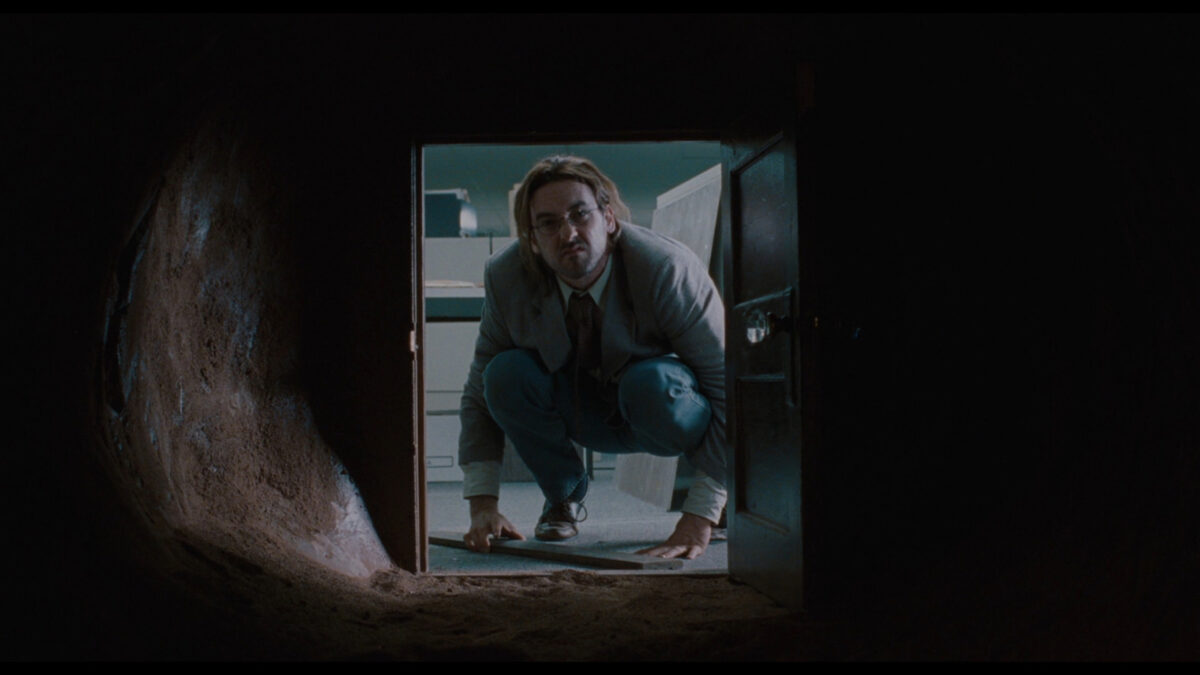
The secretary who works for Lester consistently mistranslates and mishears what everyone says. She also makes aggressive sexual advances towards Craig, and is angry when rebuffed. What does she represent?